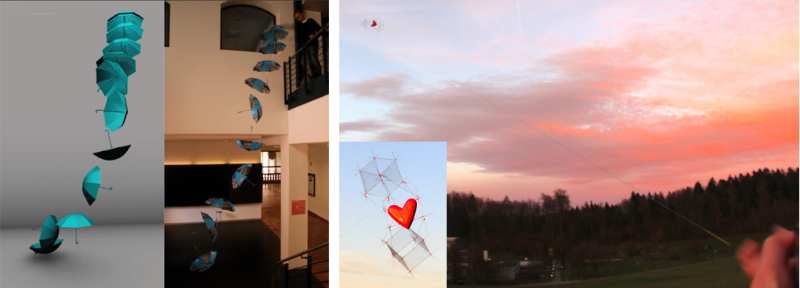Data-driven method provides simple means of calculating aerodynamics of light, 3-D objects

Obtaining the aerodynamic properties necessary to simulate falling leaves or a tumbling box caught by the wind can be as simple as dropping the object off of a balcony and recording the fall, thanks to OmniAD, a data-driven technique developed at Disney Research.
You would not want to design an airplane with this method, but the results are good enough for simulating aerodynamic effects of light, 3-D objects in videogames and animations, said Nobuyuki Umetani of Disney Research and Tobias Martin of ETH Zurich. The system can even be used to design kites that actually fly, which the researchers used to verify their method.
The researchers will present Omni-directional AeroDynamics, or OmniAD, at ACM SIGGRAPH 2015, the International Conference on Computer Graphics and Interactive Techniques, in Los Angeles Aug. 9-13.
Traditionally, measuring how an object's surface geometry interacts with surrounding air has required time-intensive wind tunnel testing or the use of expensive fluid dynamics simulations. Neither method is for amateurs and both represent technical overkill for computer graphics designers who simply want to realistically depict a lost hat tumbling in the breeze or a shower of tickertape wafting over a parade.
Umetani and Martin, along with Bernd Bickel of the Institute of Science and Technology Austria, showed that OmniAD can obtain the information needed to calculate the aerodynamic forces on a lightweight object by dropping it from a second-story balcony.
The researchers attached markers to the object before dropping it 6-8 times from various starting configurations, recording each fall with a single camera. From these video sequences, the system is able to reconstruct the 3-D motion of the object based on the markers and to infer the aerodynamic forces. The parameters obtained this way can then be used to simulate the object in a game or animated film, adjusting for size and number of objects and for varying air conditions.
To demonstrate the validity of the method, the researchers used it to form the core of a design system for freeform box kites called KiteShop.
"Constructing an aerodynamically functional object such as a kit is difficult because it requires an in-depth understanding of aerodynamic forces," Umetani said.
With KiteShop, users can nevertheless explore novel kite design by combining primitive shapes with known OmniAD properties. The system enables users to gain an intuitive understanding of the lift forces, drag forces, torque and string tension forces involved in a feasible kite design.
More information: www.disneyresearch.com/publication/omniad/
Provided by Disney Research




















